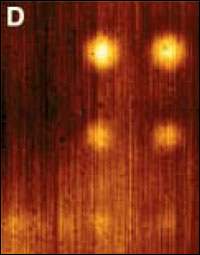
New 'Superlens' Reveals Hidden Nanostructures
AUSTIN, Texas, Sept. 18, 2006 -- In a development that could enhance near-field microscopy, a 'superlens' made of a thin film of silicon carbide sandwiched between two layers of silicon oxide has enabled the first direct near-field optical images. Integrating a superlens into a scanning optical microscope, researchers said, could be useful in industrial applications and in the imaging of biological objects in their natural environment.
A microscope used to scan nanostructures can be dramatically enhanced by using a superlens, reports an international team of scientists from the Max Planck Institute (MPI) for Biochemistry and The University of Texas at Austin (UT) this month in Science. This is the first time a superlens, a lens capable of creating images of objects smaller than the wavelength of light, has been integrated into a microscope and used to visualize two-dimensional objects.
Near-field microscopy with a superlens: Infrared phase-contrast image of holes in a slab of material. The largest two holes are 1200 nm in diameter. Five smaller holes of 540 nm diameter can just be seen at the bottom of the image. (Image courtesy of Science.)
The team of scientists produced images of holes in a gold film that were smaller than a wavelength of light, about 500 nm in diameter, by equipping a near-field scanning optical microscope with a newly fabricated superlens.
"Though the idea of a superlens was invented in 2000, it has been unclear how, or if, a superlens could be integrated into an imaging system," said Gennady Shvets, associate professor of physics at UT. "Nor has it been demonstrated that ultrasmall two-dimensional objects, such as holes or nanodiscs, can be imaged by a superlens.
"We were able to image a two-dimensional object--holes in a surface. Such imaging would be impossible without the superlens." The resolution of conventional optical microscopes is limited to about half the wavelength of the light used to illuminate an object. The superlens was invented by Sir John Pendry in 2000 to overcome that limit and make images of very tiny objects.
The new superlens was fabricated at UT using specialized equipment at the Center for Nano and Molecular Science and Technology and the J.J. Pickle research campus. The lens, a thin film of silicon carbide, was placed between two layers of silicon oxide. A layer of gold only 60-nm thick pocked with holes of various sizes was attached to the bottom of the lens.
Researchers Thomas Taubner and Rainer Hillenbrand at MPI then used the UT superlens with a near-field scanning optical microscope to create an image of the holes in the gold layer beneath the surface of the lens. Near-field scanning optical microscopy (NSOM) works by passing a tiny probe across the surface of a specimen, producing an image of the surface line by line. While the resolution attained by NSOM is very good, it can record only the surface of a nanoscale object. The action of the scanning probe in contact with the surface also makes it difficult to visualize fragile specimens, such as living cells.
Adding the superlens to NSOM not only increases the resolution of the image, but also provides a barrier between the scanning probe and the object. "This is the first attempt to integrate a superlens into a scanning optical microscope, something that could be very useful in industrial applications," said Shvets. "One new possible application could be the imaging of biological objects in their natural environment, separated by a superlens from the probing tip."
Shvets said another application of the superlens could be the non-destructive probing of metallic interconnects buried under a layer of glass, as is commonly used in semiconductor devices. Shvets cautions there is much work to be done before applying the technique widely. His group at UT aims to make thinner silicon carbide films (50-100 nm thick) that will provide even higher resolution images.
Other UT authors of the paper are Dimitriy Korobkin, a research scientist in the physics department, and Yaroslav Urzhumov, a physics graduate student. For more information, visit: www.utexas.edu
Published: September 2006